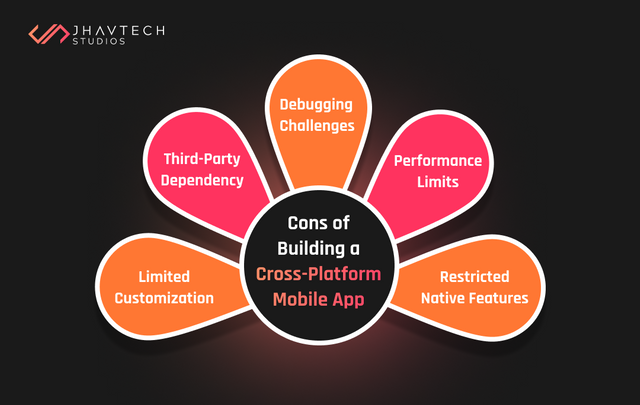.png)
In today’s digital landscape, having a mobile app is no longer optional for businesses aiming to remain competitive. With over 7 billion mobile device users globally, businesses need to create apps that cater to both iOS and Android audiences.
This growing demand has made cross-platform mobile app development a popular choice, offering efficiency and cost savings. However, this approach also has its challenges. Let’s dive into the pros and cons of building a cross-platform mobile app to help you decide whether it’s the right fit for your business.
What is a Cross-Platform Mobile App?
A cross-platform mobile app is developed using a single codebase, allowing it to function on multiple operating systems such as iOS and Android. Popular frameworks like Flutter, React Native, and Xamarin facilitate this approach, streamlining the development process. Unlike native apps, which require separate codebases for each platform, cross-platform apps are designed for quicker deployment and reduced costs, making them an appealing option for businesses of all sizes.
Pros of Building a Cross-Platform Mobile App
1. Cost-Effectiveness
Cross-platform mobile app development significantly reduces costs by eliminating the need to hire separate development teams for iOS and Android. A single codebase means fewer resources are required, making this an attractive option for startups and small businesses. According to a 2023 Clutch survey, businesses reported saving up to 40% in development costs by opting for cross-platform solutions.
2. Faster Development Time
By leveraging frameworks like Flutter or React Native, developers can write code once and deploy it across platforms. This efficiency cuts down development time considerably. On average, cross-platform mobile apps take 30–50% less time to develop compared to native apps. Faster delivery allows businesses to launch quickly, adapt to user feedback, and implement updates more promptly.
3. Wider Audience Reach
A cross-platform mobile app ensures simultaneous accessibility for iOS and Android users, maximizing market reach. As of 2024, Android holds approximately 70% of the global market share, with iOS accounting for 28%. Building a cross-platform app lets businesses tap into both segments without the need for separate development efforts, ensuring broader visibility and user engagement.
4. Easier Maintenance and Updates
Since cross-platform apps share a single codebase, updates and bug fixes can be deployed across platforms simultaneously. This consistency simplifies maintenance and reduces long-term operational costs. Moreover, a unified codebase ensures that users on both operating systems experience consistent updates and improvements.
5. Consistent User Experience
Cross-platform frameworks enable developers to create apps with a uniform design and functionality across devices. This consistency fosters a seamless user experience, regardless of whether the app is accessed on an Android or iOS device. In today’s competitive app market, a cohesive user experience is critical for building brand loyalty.
Cons of Building a Cross-Platform Mobile App
.png)
1. Limited Performance
Despite their advantages, cross-platform mobile apps often fall short of native apps in terms of performance. The additional layer of abstraction required to make the app compatible with multiple platforms can result in slower execution and occasional glitches. For resource-intensive applications, such as high-end gaming or augmented reality, this performance gap can be a critical limitation.
2. Limited Access to Native Features
Cross-platform frameworks sometimes lack full support for native device features. While they cover basic functionalities, integrating advanced features like augmented reality or Bluetooth Low Energy (BLE) sensors can be challenging. Native apps, in contrast, offer direct access to platform-specific APIs, ensuring better performance and functionality.
3. Customization Constraints
Achieving highly customized designs and interactions is more complex with cross-platform mobile apps. While frameworks like Flutter offer considerable flexibility, they may not match the level of customization achievable with native development. Businesses requiring unique UI/UX design or platform-specific designs may face limitations.
4. Dependency on Third-Party Tools
Cross-platform development relies heavily on frameworks like React Native or Flutter. If these frameworks face compatibility issues or bugs, it can disrupt development schedules and app functionality. Businesses must remain aware of updates and changes to their chosen tools to mitigate risks.
5. Increased Debugging Efforts
Although cross-platform development reduces initial coding efforts, it may lead to platform-specific bugs that require individual debugging. This can offset some of the time saved during development, especially when ensuring compatibility across different devices and operating systems.
When to Choose a Cross-Platform Mobile App
Cross-platform mobile app development is ideal for businesses prioritizing cost efficiency, speed, and audience reach. For projects with tight deadlines or limited budgets, this approach can be a game-changer. It’s especially suitable for developing MVPs (Minimum Viable Products) to test market response quickly.
When to Opt for Native Development
If your mobile app requires high performance, advanced features, or extensive customization, native development is the better option. For example, apps involving complex graphics, gaming, or intricate hardware integration are best suited to native platforms to ensure optimal functionality and user experience.
Final Thoughts...
Building a cross-platform mobile app can be a strategic choice for businesses looking to save costs, accelerate development, and target a broader audience. However, it’s essential to weigh these benefits against the potential drawbacks, such as limited performance and access to native features. By understanding your business goals and project requirements, you can determine whether cross-platform development aligns with your needs.
Ultimately, whether you choose a cross-platform or native approach, the key is to focus on delivering value and an exceptional user experience. With the right strategy, your mobile app can become a powerful tool to engage users, drive growth, and build lasting connections.